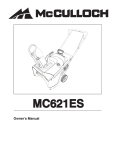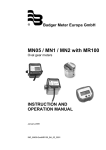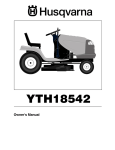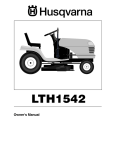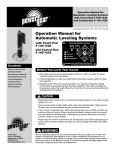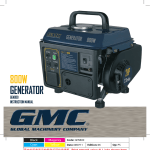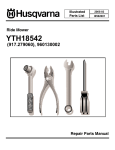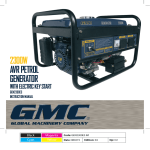Download McCulloch MC621 Owner`s manual
Transcript
MC621 Owner's Manual Gasoline containing up to 10% ethanol (E10) is acceptable for use in this machine. The use of any gasoline exceeding 10% ethanol (E10) will void the product warranty. 532 44 36-14 06.07.11 AP/TH Printed in the U.S.A. CONGRATULATIONS on your purchase of a new snow thrower. It has been designed, engineered and manufactured to give best possible dependability and performance. Should you experience any problem you cannot easily remedy, please contact your nearest authorized service center. We have competent, well-trained technicians and the proper tools to service or repair this unit. Please read and retain this manual. The instructions will enable you to assemble and maintain your snow thrower properly. Always observe the “SAFETY RULES”. Safe Operation Practices for Walk-Behind Snow Throwers IMPORTANT: This snow thrower is capable of amputating hands and feet and throwing objects. Failure to observe the following safety instructions could result in serious injury. WARNING: Snow throwers have exposed rotating parts, which can cause severe injury from contact, or from material thrown from the discharge chute. Keep the area of operation clear of all persons, small children and pets at all times including startup. Look for this symbol to point out important safety precautions. It means CAUTION!!! BECOME ALERT!!! YOUR SAFETY IS INVOLVED. WARNING: Always disconnect spark plug wire and place it where it cannot contact plug in order to prevent accidental starting when setting up, transporting, adjusting or making repairs. CAUTION: Muffler and other engine parts become extremely hot during operation and remain hot after engine has stopped. To avoid severe burns on contact, stay away from these areas. WARNING: This snow thrower is for use on sidewalks, driveways and other ground level surfaces. Caution should be exercised while using on sloping surfaces. Do not use snow thrower on surfaces above ground level such as roofs of residences, garages, porches or other such structures or buildings. WARNING: Engine exhaust, some of its constituents, and certain vehicle components contain or emit chemicals known to the State of California to cause cancer and birth defects or other reproductive harm. Training 1. Read, understand and follow all instructions on the machine and in the manual(s) before operating this unit. Be thoroughly familiar with the controls and the proper use of the equipment. Know how to stop the unit and disengage the controls quickly. 2. Never allow children to operate the equipment. Never allow adults to operate the equipment without proper instruction. 3. Keep the area of operation clear of all persons, particularly small children. 4. Exercise caution to avoid slipping or falling, especially when operating the snow thrower in reverse. Preparation 1. Thoroughly inspect the area where the equipment is to be used and remove all doormats, sleds, boards, wires, and other foreign objects. 2. Ensure the control bar is released before starting the engine. 3. Do not operate the equipment without wearing adequate winter garments. Avoid loose fitting clothing that can get caught in moving parts. Wear footwear that will improve footing on slippery surfaces. 4. Handle fuel with care; it is highly flammable (a) Use an approved fuel container. (b) Never add fuel to a running engine or hot engine. (c) Fill fuel tank outdoors with extreme care. Never fill fuel tank indoors. 5. 6. 7. 8. 2 (d) Never fill containers inside a vehicle or on a truck or trailer bed with a plastic liner. Always place containers on the ground, away from your vehicle, before filling. (e) When practical, remove gas-powered equipment from the truck or trailer and refuel it on the ground. If this is not possible, then refuel such equipment on a trailer with a portable container, rather than from a gasoline dispenser nozzle. (f) Keep the nozzle in contact with the rim of the fuel tank or container opening at all times, until refueling is complete. Do not use a nozzle lock-open device. (g) Replace gasoline cap securely and wipe up spilled fuel. (h) If fuel is spilled on clothing, change clothing immediately. Use extension cords and receptacles as specified by the manufacturer for all units with electric drive motors or electric starting motors. Never attempt to make any adjustments while the engine (motor) is running (except when specifically recommended by manufacturer). Always wear safety glasses or eye shields during operation or while performing an adjustment or repair to protect eyes from foreign objects that may be thrown from the machine. Let engine and machine adjust to outdoor temperatures before starting to clear snow. Operation Maintenance and Storage 1. Do not put hands or feet near or under rotating parts. Keep clear of the discharge opening at all times. 2. Exercise extreme caution when operating on or crossing gravel drives, walks, or roads. Stay alert for hidden hazards or traffic. 3. After striking a foreign object, stop the engine (motor), disconnect the cord on electric motors, thoroughly inspect the snow thrower for any damage, and repair the damage before restarting and operating the snow thrower. Remove key. 4. If the unit should start to vibrate abnormally, stop the engine (motor) and check immediately for the cause. Vibration is generally a warning of trouble. 5. Stop the engine (motor) whenever you leave the operating position, before unclogging the auger housing or discharge chute, and when making any repairs, adjustments or inspections. 6. When cleaning, repairing or inspecting the snow thrower, stop the engine and make certain the auger blades and all moving parts have stopped. Remove key. 7. Do not run the engine indoors, except when starting the engine and for transporting the snow thrower in or out of the building. Open the outside doors; exhaust fumes are dangerous. 8. Exercise extreme caution when operating on slopes. 9. Never operate the snow thrower without proper guards, and other safety protective devices in place and working. 10. Never direct the discharge toward people or areas where property damage can occur. Keep children and others away. 11. Do not overload the machine capacity by attempting to clear snow at too fast a rate. 12. Never operate the machine at high transport speeds on slippery surfaces. Look behind and use care when operating in reverse. 13. Disengage power to the auger blades when snow thrower is transported or not in use. 14. Use only attachments and accessories approved by the manufacturer of the snow thrower. 15. Never operate the snow thrower without good visibility or light. Always be sure of your footing, and keep a firm hold on the handles. Walk; never run. 16. Never touch a hot engine or muffler. 1. Check shear bolts and other bolts at frequent intervals for proper tightness to be sure the equipment is in safe working condition. 2. Never store the machine with fuel in the fuel tank inside a building where ignition sources are present such as hot water heaters, space heaters, or clothes dryers. Allow the engine to cool before storing in any enclosure. 3. Always refer to operator’s manual for important details if the snow thrower is to be stored for an extended period. 4. Maintain or replace safety and instruction labels, as necessary. 5. Run the machine a few minutes after throwing snow to prevent freeze-up of the collector/impeller. SERIAL NUMBER: ___________________________ DATE OF PURCHASE: _______________________ THE MODEL AND SERIAL NUMBERS WILL BE FOUND ON A DECAL ATTACHED TO THE REAR OF THE SNOW THROWER HOUSING (Figure 1). YOU SHOULD RECORD BOTH SERIAL NUMBER AND DATE OF PURCHASE AND KEEP IN A SAFE PLACE FOR FUTURE REFERENCE. PRODUCT MAINTENANCE LEVEL SERIAL MODEL CATALOG FOR SERVICE CALL 1-800-849-1297 CONFORMS TO ANSI B71.3-2005 SAFETY STANDARDS ASSEMBLED IN U.S.A. Orangeburg, SC 29118 407435 Figure 1 CUSTOMER RESPONSIBILITIES • • • Clearing a Clogged Discharge Chute Read and observe the safety rules. Follow a regular schedule in maintaining, caring for and using your snow thrower. Follow the instructions under “Maintenance” and “Storage” sections of this manual. PRODUCT SPECIFICATIONS Hand contact with the rotating auger blades inside the discharge chute is the most common cause of injury associated with snow throwers. Never use your hand to clean out the discharge chute. To clear the chute: 1. SHUT THE ENGINE OFF! 2. Wait 10 seconds to be sure the auger blades have stopped rotating. 3. Always use a clearing tool at least 15 inches long. 3 Gasoline Capacity and Type: 1.6 Quarts (1,5 Liters) Unleaded Regular only Oil Type (API SG–SL): SAE 30 (above 50°F) SAE 5W-30 or 10W-30 (32° to 50°F) SAE 5W-30 (below 32°F) Oil Capacity: 18 Ounces (0,53 Liters) Spark Plug: Gap: F6RTC 0.030" (0,762 mm) TABLE OF CONTENTS MAINTENANCE ..................................................... 12-16 STORAGE ................................................................... 17 TROUBLESHOOTING ................................................ 18 REPAIR PARTS ..................................................... 19-29 WARRANTY................................................................ 30 SAFETY RULES ........................................................ 2-3 PRODUCT SPECIFICATIONS ...................................... 3 CUSTOMER RESPONSIBILITIES................................ 3 SAFETY AND INSTRUCTIONAL DECALS ................. 4 SETUP........................................................................ 5-6 OPERATION ............................................................ 7-11 KNOW YOUR SNOW THROWER READ THIS OWNER'S MANUAL AND ALL SAFETY RULES BEFORE OPERATING YOUR SNOW THROWER. Compare the illustrations with your snow thrower to familiarize yourself with the location of various controls and adjustments. Save this manual for future reference. These symbols may appear on your snow thrower or in literature supplied with the product. Learn and understand their meaning. IMPORTANT: Safety and instruction decals are located near areas of potential danger. Replace damaged decals. 2 DANGER OR WARNING CHOKE PRIMER READ AND FOLLOW ALL SAFETY INFORMATION AND INSTRUCTIONS BEFORE USE OF THIS PRODUCT. KEEP THESE INSTRUCTIONS FOR FUTURE REFERENCE. IGNITION KEY. INSERT TO START AND RUN, PULL OUT TO STOP. 4 Setup Loose Parts Use the chart below to verify that all parts have been shipped. Procedure 1. 2. Description Qty. Use No parts required – Unfold the handle. Carriage bolts Flange nuts Washers Knob Chute Deflector 5 4 2 1 1 1 Install the discharge chute. Install the discharge chute. Install the discharge chute. Install the discharge chute. 1. Unfolding the Handle 2. Installing the Discharge Chute Procedure 1. Loosen the two handle knobs and pull out the two handle bolts until you can move the handle freely and rotate the handle to the operating position (Figure 2). 5 Carriage bolts 4 Flange nuts 2 Washers 1 Knob 1 Chute 1 Deflector Procedure 1 1. Install the chute deflector to the discharge chute using two screws, washers, nut and deflector knob (Figure 4). 2. Install the discharge chute to the chute base using three screws and nuts (Figure 4). 2 2 5 Figure 2 1. Handle knobs 43 4 1 2. Handle bolt 6 3 3 2. Tighten the handle knobs until they are snug (Figure 3). 2 2 Figure 4 1. Deflector 2. Carriage bolts 3. Flange nuts 4. Washer 5. Knob 6. Discharge chute Figure 3 5 IMPORTANT: Do not overtighten the flange nuts; otherwise you may damage the discharge chute. 3. Filling the Engine with Oil Product Overview ENGINE See engine manual. 13 LUBRICATION NOTE: SAE 10W30 or SAE 5W30 oil is acceptable for use in cold temperatures if engine is difficult to start. 1 4 2 NOTE: Although multi-viscosity oils (5W30, 10W30 etc.) improve starting in cold weather, these multi-viscosity oils will result in increased oil consumption when used above 32°F. Check your engine oil level more frequently to avoid possible engine damage from running low on oil. Change the oil after every 25 hours of operation or at least once a year if the snow thrower is not used for 25 hours in one year. Check the crankcase oil level before starting the engine and after each five (5) hours of continuous use. Tighten oil fill cap / dipstick securely each time you check the oil level. 1. Move the snowthrower to a level surface. 12 3 5 *11 6 7 8 2. Clean around the dipstick (Figure 5). NOTE: Dipstick location may vary depending on engine type. 10 3. Remove either side mounted filler cap dipstick or high oil fill dipstick and wipe it clean. 9 *11 Figure 6 1. 2. 3. 4. 5. 6. 7. 1 Fill if oil is below “Add” on the GLSVWLFN Fill if oil is below letter “L” on the ¿OOHUFDS Discharge chute Chute deflector handle Fuel tank cap Control bar Recoil start handle Primer Choke lever 8. 9. 10. *11. 12. 13. Electric-start button (if equipped) Oil drain plug Drive belt cover Oil fill cap/dipstick Ignition key Chute deflector * Dipstick location may vary depending on engine type. Figure 5 1. Oil filler cap/dipstick 4. Insert the dipstick into the filler neck and turn clockwise until fully seated. Then remove the dipstick by turning it counter-clockwise. 5. Fill oil to "FULL" on dipstick with the recommended oil. 6. Securely screw in the oil filler cap/dipstick. 6 NOTE: For best results, purchase only the quantity of gasoline that you expect to use in 30 days. Otherwise, you may add fuel stabilizer to newly purchased gasoline to keep it fresh for up to 6 months. Operation NOTE: Determine the left and right sides of the machine from the normal operating position. Checking the Engine Oil Level • Gasoline is extremely flammable and explosive. A fire or explosion from gasoline can burn you and others. • To prevent a static charge from igniting the gasoline, place the container and/or snowthrower on the ground before filling, not in a vehicle or on an object. • Fill the tank outdoors when the engine is cold. Wipe up spills. • Do not handle gasoline when smoking or around an open flame or sparks. • Store gasoline in an approved fuel container, out of the reach of children. • Do not tip the snowthrower with fuel in the fuel tank. 1. Move the snowthrower to a level surface. 2. Clean around the dipstick (Figure 8). NOTE: Dipstick location may vary depending on engine type. 3. Remove either side mounted filler cap dipstick or high oil fill dipstick and wipe it clean. 1 Fill if oil is below “Add” on the GLSVWLFN The operation of any snow thrower can result in foreign objects thrown into the eyes, which can result in severe eye damage. Always wear safety glasses or eye shields while operating your snow thrower or performing any adjustments or repairs. We recommend standard safety glasses or a wide vision safety mask worn over spectacles. IMPORTANT: Know how to operate all controls before adding fuel or attempting to start the engine. Fill if oil is below letter “L” on the ¿OOHUFDS Figure 8 1. Oil filler cap/dipstick Filling the Fuel Tank 4. Insert the dipstick into the filler neck and turn clockwise until fully seated. Then remove the dipstick by turning it counter-clockwise. Fill the fuel tank with fresh unleaded gasoline (minimum 87 AKI octane rating) (Figure 7). 5. Fill oil to "FULL" on dipstick with the recommended oil. 6. Securely screw in the oil filler cap/dipstick. NOTE: Running the engine with a low oil level can cause engine damage. Always check the engine oil before start up. NOTE: Running the engine with too much oil may cause engine damage and excess smoke in the exhaust. Always check the engine oil level before start up. Figure 7 IMPORTANT: Do not add oil to the gasoline. IMPORTANT: Do not use E85 blended fuels. This engine is not E20/E30/E85 compatible. Alternative fuels with high alcohol content can cause hard starting, poor engine performance, and may cause internal engine damage. 7 3. Firmly push in the primer 2 times with your thumb, holding the primer in a for a second before releasing it each time (Figure 11). Starting the Engine 1. Push key in (Figure 9). 1 1 Figure 11 1. Primer Figure 9 1. Key NOTE: Remove your glove when you push in the primer so that air cannot escape from the primer hole. IMPORTANT: It may not be necessary to use the primer or the choke if the engine has been running and is hot. Excessive priming may flood the engine and prevent it from starting. 2. Move choke lever to left position (Figure 10). 4. Pull the recoil starter or if your snow thrower is equipped with an electric starter, connect an extension cord to the snow thrower and plug the other end into a threehole grounded 110 volt A.C. receptacle and push the electric-start button (Figure 12). 1 Figure 10 1 1. Choke lever Figure 12 1. Electric start button NOTE: Use an extension cord recommended for outdoor use that is not longer than 50 feet (15 m). 8 Engaging the Auger Blades The electrical cord can become damaged, causing a shock or fire. Thoroughly inspect the electrical cord before plugging it into a power source. If the cord is damaged, do not use it to start the snowthrower. Replace or repair the damaged cord immediately. Contact an Authorized Service Dealer for assistance. To engage the auger blades, hold the control bar against the handle (Figure 14). 1 1 Figure 14 1. Control bar Disengaging the Auger Blades Figure 13 1. Recoil start handle To disengage the auger blades, release the control bar (Figure 15). IMPORTANT: Run the electric starter no more than 10 times at intervals of 5 seconds on, then 5 seconds off. Running the electric starter extensively can overheat and damage it. If the engine does not start after this series of attempts, wait at least 40 minutes to allow the starter to cool before attempting to start it again. If the engine does not start after the second series of attempts, take the snowthrower to an Authorized Service Dealer for service. NOTE: If you pull the recoil handle and feel no resistance, the starter may be frozen. Thaw out the starter before attempting to start the snowthrower. 1 5. While the engine is running, move the choke lever slowly to the right position. 6. Unplug the extension cord from the power source and the snowthrower (Figure 12). Unplug the power cord whenever you are not starting the snowthrower. Figure 15 1. Control bar 9 IMPORTANT: During initial operation there may be wear between the auger blades and the scraper bar. Maximum performance, both snow throwing and driving, occurs when there is zero clearance between these two parts (Figure 16). Adjusting the Discharge Chute and Chute Deflector To adjust the discharge chute, move deflector chute handle left or right to desired position (Figure 18). During initial break-in period of the auger blades it is normal for the auger blades to build up excessive heat if not operated in the snow. Do not operate without snow or water for lubricating the auger blades. This will cause excessive heat build up in the auger blades which could cause damage to the auger blades and scrapper bar. 1 3 2 1 Figure 18 2 1. Chute deflector knob 2. Chute deflector 3. Chute handle Figure 16 1. Rub Area 2. Wear Areas Stopping the Engine To raise or lower the angle of the chute deflector, loosen the chute deflector knob on the chute deflector and move the chute deflector up or down (Figure 18). To stop the engine, pull key out (Figure 17). 1 1. Key Figure 17 10 Clearing a Clogged Discharge Chute Operating Tips The auger blades can throw stones, toys, and other foreign objects and cause serious personal injury to the operator or to bystanders. • Keep the area to be cleared free of all objects that the auger blades could pick up and throw. • Keep all children and pets away from the area of operation. • Do not operate snow thrower if weather conditions impair visibility. Throwing snow during a heavy, windy snowstorm can blind you and be hazardous to the safe operation of the snow thrower. Hand contact with the rotating auger blades inside the discharge chute is the most common cause of injury associated with snow throwers. Never use your hand to clean out the discharge chute. To clear the chute: 1. SHUT THE ENGINE OFF! 2. Wait 10 seconds to be sure the auger blades have stopped rotating. 3. Always use a clearing tool at least 15 inches long, not your hands (Figure 19). • • • • • • • • Figure 19 Preventing Freeze-up after Use • Let the engine run for a few minutes to prevent moving parts from freezing. Stop the engine, wait for all moving parts to stop, and remove ice and snow from the snowthrower. • Clean off any snow and ice from the base of the chute. • Rotate the discharge chute left and right to free it from any ice buildup. • With the ignition key in the Off position, pull the recoil starter handle several times or connect the electrical cord to a power source and the snowthrower and push the electric start button once to prevent the recoil starter and/or the electric starter from freezing up. • In snowy and cold conditions, some controls and moving parts may freeze. Do not use excessive force when trying to operate frozen controls. If you have difficulty operating any control or part, start the engine and let it run for a few minutes. 11 The best time to remove snow is the early morning. At this time the snow is usually dry and has not been exposed to the direct sun and warming temperatures. Slightly overlap each successive path to ensure all snow will be removed. Throw snow downwind whenever possible. For extremely heavy snow, reduce the width of snow removal by overlapping previous path and moving slowly. Keep engine clean and clear of snow during use. This will help air flow and extend engine life. After snow-throwing is completed, allow engine to run for a few minutes to melt snow and ice off the engine. Clean the entire snow thrower thoroughly after each use and wipe dry so it is ready for next use. Spraying off unit with a hose is NOT recommended. Maintenance NOTE: Determine the left and right sides of the machine from the normal operating position. Check for Loose Fasteners Clean / Inspect Snow Thrower Clean / Replace V-Belts Check / Replace Auger Blades and Scraper Bar Lubrication Chart Check Engine Oil Level Change Engine Oil Inspect Muffler Check / Replace Spark Plug Empty Fuel Tank 12 Adjusting the Control Cable Adjusting the Control Cable Checking the Control Cable 1. With the control bar disengaged, unhook and move the control cable to the highest position. (Figure 21). Release the control bar to remove the slack in the control cable (Figure 20). 1 Position 2 2 3 1 Position 1: Default position (Lower Hole as shown in illustration) Figure 21 1. Control bar 2. Adjuster link 3. Cable positions Figure 20 Inspecting the Auger Blades/ Scraper Bar 1. Control bar IMPORTANT: The control cable must contain some slack when you disengage the control bar for the auger blades to stop properly. Before each session, inspect the auger blades for wear. When an auger blade edge or the scraper bar has worn down have an Authorized Service Dealer replace the auger blades and the scraper bar (Figure 22). NOTE: You may need to adjust the control cable from position 1 (default) to position 2 if you notice belt slip when the control bar is engaged. NOTE: Auger blades and scraper bar are wear items and may have to be replaced after extended use. NOTE: If the control cable is adjusted to position 2, ensure that the auger stops properly when the control bar is released 1 2 Figure 22 1. Auger blades 13 2. Scraper bar 7. Clean around the oil filler cap/dipstick (Figure 24). 8. Unscrew the oil fill cap/dipstick and remove it (Figure 25). 9. With the snowthrower in the operating position, carefully pour oil into the oil fill hole until "Full" on the fill cap/dipstick line (Figure 25). Changing the Engine Oil Run the engine a few minutes before changing the oil to warm it. Warm oil flows better and carries more contaminants. Max fill: 18 oz. (0.5 l), type: automotive detergent oil with an API service classification of SJ, SL, or higher. The engine oil will be hot. Avoid skin contact with the used engine oil. 1. Move snowthrower to a level surface. 2. Run snowthrower until all fuel has been depleted. 3. Remove ignition key. Fill if oil is below “Add” on the GLSVWLFN Fill if oil is below letter “L” on the ¿OOHUFDS Figure 25 1 10. Screw in the oil fill cap/dipstick and hand tighten it securely. 11. Wipe up any spilled oil. 12. Dispose of the used oil properly at a local recycling center. Figure 23 1. Oil drain plug 4. Place an oil drain pan under the oil drain plug, remove the oil drain plug, and tip the snowthrower backward and drain the used oil in the oil drain pan (Figure 23). 5. After draining the used oil, return the snowthrower to the operating position. 6. Install the oil drain plug and torque to 145-150 in-lbs (17 N-m). NOTE: Dipstick location may vary depending on engine type. 1 1 Figure 24 1. Oil fill cap/dipstick 14 Servicing the Spark Plug 5. 6. 7. 8. Remove the oil fill cap. Remove the shroud assembly (Figure 27). Install the oil fill cap. Disconnect the spark plug wire from the spark plug (Figure 28). 9. Clean around the spark plug. 10. Remove the spark plug from the cylinder head. Use a NGK BPR6ES, Champion RN9YC, or BOSCH WR6DC spark plug or equivalent. 1. Stop the engine and wait for all moving parts to stop. 2. Rotate the discharge chute so that it faces forward. 3. Remove the discharge chute and the discharge chute handle by removing the three carriage bolts and three flange nuts (Figure 26). 1 1 3 3 2 2 Figure 28 1. Spark plug wire IMPORTANT: Replace a cracked, fouled, or dirty spark plug. Do not clean the electrodes because grit entering the cylinder can damage the engine. 11. Set the gap on the plug to 0.030 inch (0.76 mm) (Figure 29). Figure 26 1. Discharge chute 3. Flange nuts 2. Carriage bolts 0.030 inch (0.76 mm) 4. Remove the six screws that secure the shroud assembly (Figure 29). 1 2 Figure 29 12. Install the spark plug and torque it to 20–22 ft-lb (27–30 N-m). 13. Connect the spark plug wire to the spark plug (Figure 28). 3 14. Remove the oil fill cap. 15. Install the shroud with the screws removed in step 4 (Figure 27). Figure 27 1. Screw 2. Shroud assembly NOTE: Ensure that the shroud assembly fits together in the side grooves. 3. Oil fill cap 16. Install the oil fill cap. 17. Install the discharge chute, and the discharge chute handle onto the snowthrower using the hardware removed in step 3 (Figure 26). 15 4. Install the new drive belt, routing it as shown in (Figure 31). NOTE: Route the new drive belt first around the engine pulley, then the idler pulley, and finally around the drive pulley while pressing down on the front of the idler arm. (Figure 31). Replacing the Drive Belt If drive belt becomes worn, oil-soaked, excessively cracked, frayed, or otherwise damaged, replace the belt. 1. Remove the drive side cover by removing the six screws as shown in (Figure 30). 5 5. Install the drive side cover with the screws removed in step 1. 3 2 1 6 4 7 2 1 3 2 Figure 30 1. 2. 3. 4. Drive side cover Screw Drive pulley Idler arm 4 Figure 31 5. Idler pulley 6. Engine pulley 7. Drive belt 1. 2. 3. 4. 2. Press down on front of idler arm to release the belt tension (Figure 30). 3. Remove the drive belt from the drive pulley (Figure 30). Idler arm Idler pulley Engine pulley Drive pulley NOTE: Ensure that the drive belt is properly adjusted and operating; refer to Checking the Control Cable and Adjusting the Control Cable in the Maintenance section of this manual. 16 ENGINE OIL Drain oil (with engine warm) and replace with clean engine oil. (See “Changing the Engine Oil” section of this manual). Storage Storing the Snowthrower CYLINDER 1. Remove spark plug. 2. Pour one ounce (29 ml) of oil through spark plug hole into cylinder. 3. Pull recoil starter handle slowly a few times to distribute oil. Immediately prepare your snow thrower for storage at the end of the season or if the unit will not be used for 30 days or more. WARNING: Never store the snow thrower with gasoline in the tank inside a building where fumes may reach an open flame, spark or pilot light as on a furnace, water heater, clothes dryer or gas appliance. Allow the engine to cool before storing in any enclosure. OTHER • • • Remove safety ignition key; store it in a safe place. Do not store gasoline from one season to another. Replace your gasoline can if your can starts to rust. Rust and/or dirt in your gasoline will cause problems. • If possible, store your snow thrower indoors and cover it to protect it from dust and dirt. • Cover your snow thrower with a suitable protective cover that does not retain moisture. Do not use plastic. Plastic cannot breathe, which allows condensation to form and will cause your snow thrower to rust. IMPORTANT: Never cover snow thrower while engine/ exhaust area is still warm. SNOW THROWER When snow thrower is to be stored for a period of time, clean it thoroughly, remove all dirt, grease, leaves, etc. Store in a clean, dry area. 1. Clean entire snow thrower after each use. 2. Inspect and replace belts, if necessary (See “Replaceing the Drive Belt” section of this manual). 3. Be sure that all nuts, bolts, screws, and pins are securely fastened. Inspect moving parts for damage, breakage and wear. Replace if necessary. FUEL SYSTEM IMPORTANT: It is important to prevent gum deposits from forming in essential fuel system parts such as carburetor, fuel hose, or tank during storage. Also, alcohol blended fuels can attract moisture which leads to separation and formation of acids during storage. Acidic gas can damage the fuel system of an engine while in storage. • Empty the fuel tank by starting the engine and letting it run until the fuel lines and carburetor are empty. • Never use engine or carburetor cleaner products in the fuel tank or permanent damage may occur. • Use fresh fuel next season. NOTE: Fuel stabilizer is an acceptable alternative in minimizing the formation of fuel gum deposits during storage. Add stabilizer to gasoline in fuel tank or storage container. Always follow the mix ratio found on stabilizer container. Run engine at least 10 minutes after adding stabilizer to allow the stabilizer to reach the carburetor. Do not empty the gas tank and carburetor if using fuel stabilizer. 17 Troubleshooting See appropriate section in manual unless directed to an authorized service center/department. PROBLEM CAUSE CORRECTION Does not start 1. Safety ignition key is not inserted. 1. Insert safety ignition key. 2. Out of fuel. 2. Fill fuel tank with fresh, clean gasoline. Loss of power 3. ON/OFF switch is OFF. 3. Move ON/OFF switch to ON position. 4. Choke in OFF position. 4. Move to FULL position. 5. Primer not depressed. 5. Prime as instructed in the Operation section of this manual. 6. Engine is flooded. 6. Wait a few minutes before restarting, DO NOT prime. 7. Spark plug wire is disconnected. 7. Connect wire to spark plug. 8. Bad spark plug. 8. Replace spark plug. 9. Stale fuel. 9. Empty fuel tank & carburetor, refill with fresh, clean gasoline. 10. Water in fuel. 10. Empty fuel tank & carburetor, refill with fresh, clean gasoline. 11. Vapor locked fuel line. 11. Ensure all the fuel line is below the outlet of the fuel tank. Fuel line should run continuously down from fuel tank to carburetor. 1. Spark plug wire loose. 1. Reconnect spark plug wire. 2. Throwing too much snow. 2. Reduce speed and width of swath. 3. Fuel tank cap is covered with ice or 3. Remove ice and snow on and around fuel tank cap. snow. Engine idles or runs roughly Excessive vibration / Handle movement Recoil starter is hard to pull 4. Dirty or clogged muffler. 4. Clean or replace muffler. 5. Improper cable length. 5. Adjust cable. 6. Blocked muffler. 6. Clear blockage (ensure engine is cool). 7. Blocked carburetor air intake. 7. Clear blockage (ensure engine is cool). 1. Choke is in FULL position. 1. Move choke to OFF position. 2. Blockage in fuel line. 2. Clean fuel line. 3. Stale fuel. 3. Empty fuel tank & carburetor, refill with fresh, clean gasoline. 4. Water in fuel. 4. Empty fuel tank & carburetor, refill with fresh, clean gasoline. 5. Carburetor is in need of replacing 5. Contact an authorized service center/department. 6. Belt stretch. 6. Replace auger v-belt. 1. Loose parts or damaged augers or impeller. 1. Tighten all fasteners. Replace damaged parts. If vibration remains, contact an authorized service center/department. 2. Handles not positioned correctly. 2. Ensure handles are locked into positioning. 3. Adjustment lever nuts are loose. 3. Tighten nuts until handle feels secure. 1. Frozen recoil starter. 1. See “IF RECOIL STARTER HAS FROZEN” in the Operation section of this manual. 2. Rope is interfering with components. 2. Recoil rope should not be touching any wires or hoses. Loss of snow discharge or slowing of snow discharge 1. Worn belt. 1. Adjust drive cable per maintenance procedures. 2. Auger v-belt is off of pulley. 2. Check / reinstall auger v-belt. 3. Auger v-belt is worn. 3. Check / replace auger v-belt. 4. Clogged discharge chute. 4. Clean snow chute. 5. Augers / impeller jammed. 5. Remove debris or foreign object from augers / impeller. Lights not On (If Equipped) 1. Motor not running. 1. Start engine. 2. Loose wire connection. 2. Check wire connections at engine and both lights. 3. LED burnt out. 3. Replace LED light module. (Individual LEDs are not replaceable) Rotator hard to move 1. Debris in chute rotator mechanism. 1. Clean internal parts of chute rotator mechanism. 2. Cable are kinked or damaged. 2. Ensure cables are not kinked. Replace damaged cables. 18 SERVICE NOTES 19 REPAIR PARTS SNOW THROWER - - MODEL NUMBER MC621 (96182000501) CHUTE ASSEMBLY 1 4 4 2 2 4 5 18 3 6 19 19 7 17 6 8 20 15 16 9 10 15 11 21 SSST-Chute asm_5 19 4 NOTE: All component dimensions given in U.S. inches. 1 inch = 25.4 mm IMPORTANT: Use only Original Equipment Manufacturer (O.E.M.) replacement parts. Failure to do so could be hazardous, damage your snow thrower and void your warranty. 20 REPAIR PARTS SNOW THROWER - - MODEL NUMBER MC621 (96182000501) CHUTE ASSEMBLY KEY NO. PART NO. QTY DESCRIPTION 1 532 43 48-77 1 CHUTE.RATCHETING.PLASTIC.W/GRV 2 532 43 76-40 2 PLATE.CHUTE.RETAINER 3 532 43 76-35 1 PLATE.CHUTE.BASE 4 817 41 13-12 6 BOLT.HEX.WSH.HD.13-16 X 3/4 5 532 43 76-42 1 HANDLE.CHUTE.MS428 6 873 97 05-00 4 NUT.LOCK.HX.W/INS 5/16-18 UNC PL 7 532 43 48-79 1 SPRING.RATCHET.ARM 8 532 08 13-28 1 BOLT.SHOULDER.1/4-20 UNC X .94 9 532 43 48-78 1 ARM.CHUTE.RATCHET 10 532 13 20-04 1 HEX.NUT.1/4-20 NYLON LOCKING 11 532 44 33-96 1 PLENUM 15 532 43 73-18 5 CARRIAGE.BOLT 16 532 43 76-55 1 CHUTE 17 532 19 19-38 1 HANDLE.KNOB 18 532 43 76-43 1 DEFLECTOR.CHUTE 19 819 13 13-16 3 WASHER 20 819 13 24-16 1 WASHER.RATCHET.PAWL 21 532 42 88-67 1 BOLT NOTE: All component dimensions given in U.S. inches. 1 inch = 25.4 mm IMPORTANT: Use only Original Equipment Manufacturer (O.E.M.) replacement parts. Failure to do so could be hazardous, damage your snow thrower and void your warranty. 21 REPAIR PARTS SNOW THROWER - - MODEL NUMBER MC621 (96182000501) SHROUD ASSEMBLY 16 5 6 14 1 7 17 17 10 15 17 3 2 10 8 9 4 10 12 SSST-Shroud asm_16 11 NOTE: All component dimensions given in U.S. inches. 1 inch = 25.4 mm IMPORTANT: Use only Original Equipment Manufacturer (O.E.M.) replacement parts. Failure to do so could be hazardous, damage your snow thrower and void your warranty. 22 REPAIR PARTS SNOW THROWER - - MODEL NUMBER MC621 (96182000501) SHROUD ASSEMBLY KEY NO. PART NO. QTY DESCRIPTION 1 532 44 33-97 1 COVER.NON-DRIVE.SIDE.MS428 2 532 44 33-98 1 COVER.DRIVE.SIDE.MS428 3 532 44 39-46 1 COVER.TOP.MS428 4 532 43 02-20 1 CAP.ASM.FUEL.2.25"FR.N/CB.E10 5 532 43 62-35 1 BULB.PRIMER 6 532 43 54-07 1 KEY HOUSING 7 532 43 76-48 1 TOP.REAR.COVER 8 532 43 76-31 1 PLATE.EXHAUST.PNT. 9 817 41 13-12 2 BOLT.HEX.WSH.HD.13-16 x 3/4 10 532 44 22-50 12 SCREW.HEXWSH.THDROL.1/4-20X3/4 11 532 43 48-80 1 TANK.FUEL.ASM 12 532 14 68-48 2 TIE.CABLE.24.5X.29.NYLON.WHITE 14 532 43 54-09 2 KEY 15 532 19 66-88 3 CLIP 16 532 43 62-76 1 HANDLE.STARTER 17 532 43 48-68 4 CLIPS.TRIM NOTE: All component dimensions given in U.S. inches. 1 inch = 25.4 mm IMPORTANT: Use only Original Equipment Manufacturer (O.E.M.) replacement parts. Failure to do so could be hazardous, damage your snow thrower and void your warranty. 23 REPAIR PARTS SNOW THROWER - - MODEL NUMBER MC621 (96182000501) FRAME ASSEMBLY 11 1 10 4 3 12 2 8 3 12 5 6 4 6 9 13 SSST-Frame asm_5 13 13 7 NOTE: All component dimensions given in U.S. inches. 1 inch = 25.4 mm IMPORTANT: Use only Original Equipment Manufacturer (O.E.M.) replacement parts. Failure to do so could be hazardous, damage your snow thrower and void your warranty. 24 REPAIR PARTS SNOW THROWER - - MODEL NUMBER MC621 (96182000501) FRAME ASSEMBLY KEY NO. PART NO. QTY DESCRIPTION 1 532 44 41-68 1 LCT.ENGINE.208CC 2 532 44 46-39 1 FRAME.WELDMENT 3 532 43 76-16 2 WHEEL.7X1.5.DMD.GS.3SPK.MS428 4 532 43 54-17 2 NUT.PUSH.AXLE.0.5IN 5 532 43 55-78 2 SCREW. 5/16-24 X 2.00"HHCS 6 532 15 04-06 2 BOLT.ENG. 3/8-16 X 1.280 7 532 19 17-30 3 NUT.HEX.FLANGE.1/4-20.CTR.LOCK 8 872 11 04-07 3 BOLT.RDHD.SQNK.1/4-20 UNC X 5/8 9 532 44 29-42 1 BAR.SCRAPER 10 532 43 48-57 2 SPACER.ENGINE 11 532 43 48-74 1 LEVER.CHOKE 12 817 41 13-12 2 HEX.BOLT 13 819 09 10-16 3 WASHER 9/32 X 5/8 X 16 GA NOTE: All component dimensions given in U.S. inches. 1 inch = 25.4 mm IMPORTANT: Use only Original Equipment Manufacturer (O.E.M.) replacement parts. Failure to do so could be hazardous, damage your snow thrower and void your warranty. 25 REPAIR PARTS SNOW THROWER - - MODEL NUMBER MC621 (96182000501) AUGER ASSEMBLY 2 3 1 10 11 4 14 7 56 13 9 1 12 8 9 11 12 5 5 4 13 6 10 11 SSST-Auger asm_1 7 KEY NO. PART NO. QTY 1 DESCRIPTION 1 872 11 04-07 12 BOLT.CARRIAGE 2 532 43 76-20 1 PIN.ROLL.3/16 X 1-1/4 3 532 19 96-87 1 BOLT.1/4-20.1.50" 4 532 43 76-18 2 PLATE.CENTER.BLADE 5 532 13 20-04 13 HEX.NUT.1/4-20 NYLON LOCKING 6 819 09 10-16 8 WASHER 9/32 X 5/8 X 16 GA. 7 532 44 27-59 2 BLADE.AUGER 8 532 43 76-17 1 WELDMENT.AUGER.ASM 9 532 43 76-21 2 SUPPORT.BEARING.SSST.PNT 10 532 43 76-22 2 BEARING.BALL.MANDREL 11 817 60 04-06 4 SCREW.HEX.WASHEAD.1/4-20 X 3/8 12 872 11 04-04 2 BOLT.CARR.SS.1/4-20 UNC X 1/2.GR5 13 532 43 81-30 2 WHIZ.LOCK.NUTS.BEARING CAPS 14 812 00 00-28 1 RETAINING.CLIP NOTE: All component dimensions given in U.S. inches. 1 inch = 25.4 mm IMPORTANT: Use only Original Equipment Manufacturer (O.E.M.) replacement parts. Failure to do so could be hazardous, damage your snow thrower and void your warranty. 26 REPAIR PARTS SNOW THROWER - - MODEL NUMBER MC621 (96182000501) HANDLE ASSEMBLY 1 2 5 4 3 5 6 SSST-Handle asm_1 KEY NO. PART NO. QTY DESCRIPTION 1 532 43 76-47 1 BAIL.HANDLE.PAINT.MS421 2 532 44 46-41 1 HANDLE.PNT.UPPER.SSST 3 532 43 48-06 1 CABLE.CLUTCH.ASM 4 532 19 19-38 2 KNOB.HANDLE.BLACK 5 532 19 15-74 2 BOLT.HANDLE.BLACK PATCHED 6 532 14 50-06 1 CLIP.PUSH-IN.HINGED NOTE: All component dimensions given in U.S. inches. 1 inch = 25.4 mm IMPORTANT: Use only Original Equipment Manufacturer (O.E.M.) replacement parts. Failure to do so could be hazardous, damage your snow thrower and void your warranty. 27 REPAIR PARTS SNOW THROWER - - MODEL NUMBER MC621 (96182000501) DRIVE ASSEMBLY 1 3 7 4 2 5 8 6 11 10 9 12 SSST-Drive asm_3 KEY NO. PART NO. 13 QTY DESCRIPTION 1 532 43 48-60 1 SPACER.ENGINE.CRANK 2 532 43 45-02 1 KEEPER.ENGINE.BELT 3 532 42 64-90 1 PULLEY.ENG.TRACTION.3/4 4 532 85 10-74 1 WASHER.HARDEN 5 532 43 72-61 1 BELT-V.TRACTION 6 532 43 08-17 1 SCREW.CAP.SCHD.3/8-24 X 1.25 7 532 43 48-59 1 SPRING.IDLER.PULLEY.RETURN 8 532 43 76-09 1 ARM.IDLER.PNT.MS431 9 532 16 60-43 1 PULLEY.IDLER.BACKSIDE 10 817 06 06-20 1 SCREW.HXWH.THDRL.1/4-20X1-1/4 11 532 19 90-92 1 SPACER.RETAINER 12 817 06 06-20 1 SCREW.3/8-16X1.SMGML.TAP/R.BLK 13 532 43 53-83 1 PULLEY.DRIVEN -- 532 44 36-14 1 OWNER'S.MANUAL.ENGLISH/FRENCH NOTE: All component dimensions given in U.S. inches. 1 inch = 25.4 mm IMPORTANT: Use only Original Equipment Manufacturer (O.E.M.) replacement parts. Failure to do so could be hazardous, damage your snow thrower and void your warranty. 28 SERVICE NOTES 29 REPAIR PARTS SNOW THROWER - - MODEL NUMBER MC621 (96182000501) ENGINE, LCT COMPLETE ENGINE-444168,444169,444170,444171 56 37 36 27 57 30 34 49 31 29A 62 47 38 39 10 10A 44 22A 22 53* 52* 40 41 *Included with part# 40 50 21 23 65 26 26A 48 20 20A 28 46 11 8 6 46A 19 18 3 Electric Start Only 30 17 REPAIR PARTS SNOW THROWER - - MODEL NUMBER MC621 (96182000501) ENGINE, LCT COMPLETE ENGINE-444168,444169,444170,444171 KEY PART NO. NO. 3 6 8 444277 437122 437123 10 10A 437124 437125 11 17 424954 436967 18 19 20 436968 424968 424971 20A 429230 21 22 437119 424975 22A 429596 23 26 420580 429235 26A 420585 KEY PART NO. NO. DESCRIPTION MUFFLER ASSEMBLY-SNOW SNOW CARBURETOR ASSY FUEL PRIMER BULB WITH HOSE ELECTRIC STARTER ASSY EUROPEAN 230V ELECTRIC STARTER KEY SWITCH ASSY RECOIL STARTER ASSEMBLY-SNOW STARTER CUP SMALL SNOW STARTER GRIP BLOWER HOUSING ASSEMBLY ELECTRIC START - SNOW (BLACK) BLOWER HOUSING ASSEMBLY MANUAL START - SNOW (BLACK) SHIELD, CYLINDER SHIELD, FLYWHEEL ELECTRIC START (IF EQUIPPED) SHIELD, FLYWHEEL MANUAL START VALVE COVER ELECTRIC START FLYWHEEL ASSY MANUAL START FLYWHEEL ASSY 31 27 28 29A 444091 420586 443934 30 31 34 36 37 38 39 40 41 44 46 46A 47 48 49 50 52 53 54 56 57 62 65 420606 420961 436966 420601 420602 429646 420584 420578 424939 420582 429260 444275 429599 444276 429600 429259 429691 420579 436567 429601 438014 435495 435495 DESCRIPTION HIGH OIL FILL TUBE ASSY FLYWHEEL FAN IGNITION COIL (CDI) (USED ON ENGINES WITHOUT REF. 12 CRANKCASE COVER ASSY BLACK OIL DIPSTICK SPARK PLUG BOOT GOVERNOR ARM ASSY GOVERNOR SHAFT GOVERNOR GEAR ASSY CAMSHAFT CYLINDER HEAD ASSY SPARK PLUG PISTON AND ROD ASSY VAPOR SHIELD INTAKE SHIELD SEAL KIT WIRE HARNESS CRANKSHAFT SPEED CONTROL BRACKET ROCKER ARM KIT PUSH ROD KIT CYLINDER ASSEMBLY GASKET KIT FUEL HOSE KIT NON-REMOVABLE OIL PLUG OIL DRAIN PLUG KIT LIMITED WARRANTY The Manufacturer warrants to the original consumer purchaser that this product as manufactured is free from defects in materials and workmanship. For a period of two (2) years from date of purchase by the original consumer purchaser, we will repair or replace, at our option, without charge for parts or labor incurred in replacing parts, any part which we find to be defective due to materials or workmanship. This Warranty is subject to the following limitations and exclusions. 1. This warranty does not apply to the engine, transaxle/transmission components, battery (except as noted below) or components parts thereof. Please refer to the applicable manufacturer's warranty on these items. 2. Transportation charges for the movement of any power equipment unit or attachment are the responsibility of the purchaser. Transportation charges for any parts submitted for replacement under this warranty must be paid by the purchaser unless such return is requested by the manufacturer. 3. Battery Warranty: On products equipped with a Battery, we will replace, without charge to you, any battery which we find to be defective in manufacture, during the first ninety (90) days of ownership. After ninety (90) days, we will exchange the Battery, charging you 1/12 of the price of a new Battery for each full month from the date of the original sale. Battery must be maintained in accordance with the instructions furnished. 4. The Warranty period for any products used for rental or commercial purposes is limited to 90 days from the date of original purchase. 5. This Warranty applies only to products which have been properly assembled, adjusted, operated, and maintained in accordance with the instructions furnished. This Warranty does not apply to any product which has been subjected to alteration, misuse, abuse, improper assembly or installation, delivery damage, or to normal wear of the product. 6. Exclusions: Excluded from this Warranty are belts, blades, blade adapters, normal wear, normal adjustments, standard hardware and normal maintenance. 7. In the event you have a claim under this Warranty, you must return the product to an authorized service dealer. Should you have any unanswered questions concerning this Warranty, please contact: In Canada contact: HOP Outdoor Products Customer Service Dept. 9335 Harris Corners Parkway Charlotte, NC 28269 USA HOP 5855 Terry Fox Way Mississauga, Ontario L5V 3E4 giving the model number, serial number and date of purchase of your product and the name and address of the authorized dealer from whom it was purchased. THIS WARRANTY DOES NOT APPLY TO INCIDENTAL OR CONSEQUENTIAL DAMAGES AND ANY IMPLIED WARRANTIES ARE LIMITED TO THE SAME TIME PERIODS STATED HEREIN FOR OUR EXPRESSED WARRANTIES. Some areas do not allow the limitation of consequential damages or limitations of how long an implied Warranty may last, so the above limitations or exclusions may not apply to you. This Warranty gives you specific legal rights, and you may have other rights which vary from locale to locale. This is a limited Warranty within the meaning of that term as defined in the Magnuson-Moss Act of 1975. 32


































